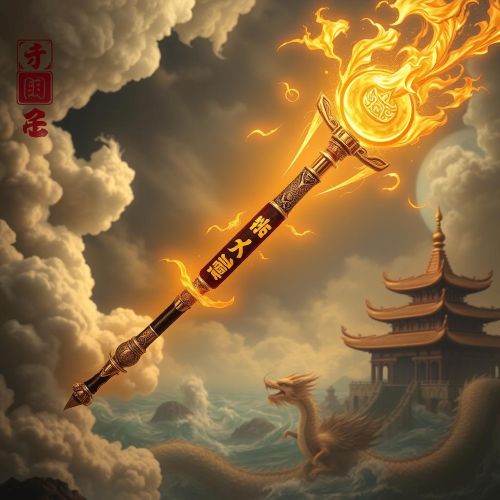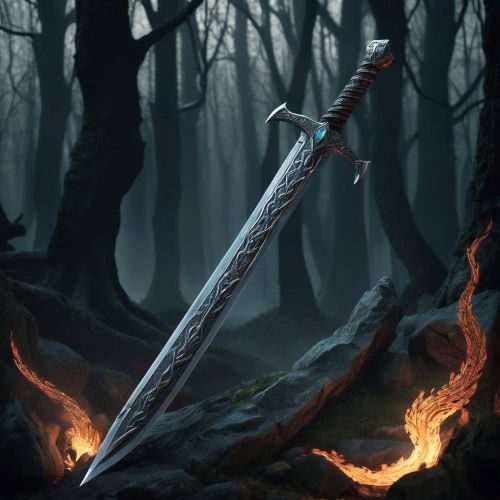Green Dragon Crescent Blade : The Chinese Blade
Green Dragon Crescent Blade
Introduction
In Chinese mythology and folklore, a few artifacts are legendary for their power and the stories woven around them. Among these is the Green Dragon Crescent Blade, famously wielded by the iconic warrior Guan Yu. This weapon is revered not only for its striking design and reputed powers but also as a symbol of loyalty, honor, and martial skill. Known as 青龍偃月刀 (Qīnglóng Yǎnyuèdāo), it stands as one of the most memorable weapons in Chinese lore. This guandao, immortalized in the historical novel *Romance of the Three Kingdoms*, represents both the spirit of ancient Chinese warfare and a deep cultural legacy tied to Guan Yu’s image as a paragon of virtue and strength.
Origins
The Green Dragon Crescent Blade holds a unique place in Chinese history and mythology, celebrated for its legendary design, mythical origins, and deep cultural symbolism. Known as a guandao—a type of polearm with a curved blade—it is famously associated with Guan Yu, the celebrated general from the Three Kingdoms period. Guan Yu’s loyalty, honor, and martial skill have made him a revered figure, and his weapon reflects those virtues.
The blade’s origin story is deeply woven into Chinese folklore, adding layers of myth to its historical roots. According to legend, Guan Yu’s weapon was forged by a skilled local blacksmith who used a special steel provided by Zhang Shiping, a merchant and ally of Liu Bei. This collaborative creation speaks to the values of loyalty and unity that Guan Yu stood for, turning the blade into more than just a weapon—it became a symbol of commitment and dedication to one’s allies.
A vivid tale in the blade’s lore tells of a dragon’s essence accidentally becoming infused with the weapon during its forging. In Chinese culture, dragons are symbols of power, strength, and good fortune, so this myth suggests that the blade carries a touch of the divine. It’s no longer merely a tool for battle but a magical artifact enriched with qualities that transcend the physical realm, enhancing its legendary status.
The Green Dragon Crescent Blade is not only a functional weapon but a potent symbol of power, endurance, and loyalty. Its role in Chinese literature, particularly in *Romance of the Three Kingdoms*, elevates it from a historical artifact to a cultural icon that embodies Guan Yu’s virtuous nature. This dual role—as both a practical weapon and a symbol of Guan Yu’s character—has given the blade a lasting presence in Chinese storytelling and history.
The design of the Green Dragon Crescent Blade emphasizes its weight and formidable presence. Historically, it was said to weigh 82 catties, or around 18 kg (40 lbs). Guan Yu was reputed to wield it with remarkable ease, a testament to his strength and martial prowess. This impressive combination of mass and agility suggests that mastery of the weapon required not just physical power but great skill, adding to the aura surrounding both the blade and its wielder.
Guandao polearms emerged during the late Han Dynasty, but the specific tale of the Green Dragon Crescent Blade is believed to have been popularized by Luo Guanzhong’s 14th-century novel *Romance of the Three Kingdoms*. This historical novel transformed the weapon into a legendary symbol of Guan Yu’s legacy, bridging history and myth in a way that continues to resonate, making the blade a timeless emblem of honor and heroism.
Think you know your myths and legends? Dive into the world of ancient stories and test your knowledge with our engaging quizzes on Mythlok!
Powers
The Green Dragon Crescent Blade holds a unique place in Chinese mythology and history, particularly as the weapon of Guan Yu, a legendary figure known for his loyalty and martial skill. Beyond its physical form, the blade is surrounded by an aura of myth, particularly through its portrayal in *Romance of the Three Kingdoms*, which has embedded it deeply into Chinese culture as a symbol of both power and honor.
Legend says that the blade carries the spirit of a dragon, imbuing it with supernatural abilities. Dragons in Chinese mythology are symbols of immense strength and wisdom, so this association elevates the blade beyond a mere weapon—it is believed to carry a mystical power that enables it to perform feats far beyond the capabilities of an ordinary sword. For instance, the blade is said to cut effortlessly through armor and defeat even the strongest adversaries, qualities that align with the image of Guan Yu as a formidable warrior.
In modern portrayals, the Green Dragon Crescent Blade often appears as a weapon of overwhelming power, depicted in video games and films as capable of defeating formidable foes with ease. This characterization not only reinforces its mythical reputation but also resonates with the archetypal fantasy trope of a hero wielding a legendary weapon to vanquish powerful enemies. The blade’s overwhelming strength suggests that it enhances the wielder’s abilities, allowing them to deliver multiple powerful strikes, adding to its allure as a tool of unmatched potency.
The blade’s tactical value is another key aspect of its legend. It is said to drain the defenses of opponents, forcing them to expend their strength in an attempt to withstand its onslaught. This ability reflects traditional martial principles that value strategy, timing, and precision over brute force alone. It turns the weapon into an extension of the wielder’s skill, making it a tool for both strategic advantage and combat supremacy.
According to legend, the Green Dragon Crescent Blade was no ordinary weapon. It was believed to possess abilities such as incredible cutting power—slicing through armor with ease—along with exceptional durability and a mystical aura that could intimidate foes. These qualities make the blade not just a relic of the past but an enduring symbol of strength and heroism that continues to captivate imaginations in both historical and fictional narratives.
Owners/Users
Guan Yu, the most legendary wielder of the Green Dragon Crescent Blade, is celebrated in Chinese culture as an embodiment of loyalty, bravery, and righteousness. His connection to the blade is so integral that he has been deified as a god of war, with temples and festivals honoring his memory and legacy. The blade itself, often depicted alongside him, has become an enduring symbol of his heroic qualities.
After Guan Yu’s death in 219 AD, the blade remained within his family, passed down to his son, Guan Xing. Guan Xing’s use of the weapon to avenge his father by killing Pan Zhang—who had received the blade as a reward for capturing Guan Yu—further entrenched its importance in Chinese martial tradition. This act of vengeance not only honored his father’s memory but also reinforced the blade’s legendary status within the Guan family.
Beyond historical and familial ties, the Green Dragon Crescent Blade appears frequently in literature, video games, and popular culture as a symbol of heroism and strength. While Guan Yu is its most iconic wielder, various fictional and artistic representations have occasionally placed the weapon in the hands of other characters. These modern portrayals, though creative reinterpretations, reflect the blade’s enduring status as a symbol of valor and martial prowess.
Instances used
The Green Dragon Crescent Blade is central to many of Guan Yu’s legendary battles, especially in the tales from *Romance of the Three Kingdoms*. At the Battle of Xiapi, Guan Yu famously used the blade to slay the formidable general Yan Liang in a single stroke, showcasing both his skill and the weapon’s lethal power. During the dramatic “Crossing of the Five Passes,” he wielded the blade to defeat multiple enemy generals, underscoring its precision and his unmatched martial prowess. In the siege of Fan Castle, his mastery with the weapon further cemented his status as an extraordinary warrior.
Beyond historical battles, the Green Dragon Crescent Blade remains a cultural icon. Its legacy lives on through modern adaptations, appearing prominently in video games like *Dynasty Warriors* and *SSS-Class Gacha Hunter*, where it symbolizes immense power and strategy. These portrayals allow new audiences to experience the blade’s legendary attributes, reimagining Guan Yu’s heroism and the weapon’s mystique for today’s fans. The blade’s role in various media has helped sustain its mythic status, making it as much a part of popular culture as it is of historical lore.
Source
Luo, Guanzhong. “Romance of the Three Kingdoms.” Foreign Languages Press, 1995.
De Crespigny, Rafe. “Imperial Warlord: A Biography of Cao Cao 155-220 AD.” Brill, 2010.
Mair, Victor H. “The Columbia Anthology of Traditional Chinese Literature.” Columbia University Press, 1994.
Eberhard, Wolfram. “A Dictionary of Chinese Symbols: Hidden Symbols in Chinese Life and Thought.” Routledge, 2006.
“Guan Yu.” Britannica, Encyclopaedia Britannica, Inc., 2021.
“Green Dragon Crescent Blade – Wikipedia.” .
Xu, T. “Romance of the Three Kingdoms.” Lianhe Kexue Chubanshe, 2018.
Liu, T. “The Historical Accuracy of Guan Yu and His Legacy.” Chinese Historical Review, vol. 20, no. 2, 2022, pp. 123-145.
Frequently Asked Questions
Lorem ipsum dolor sit amet, consectetur adipiscing?
Lorem ipsum dolor sit amet, consectetur adipiscing elit. Praesent convallis vestibulum justo, ac tincidunt nunc vehicula quis. Nullam id dolor quis orci malesuada feugiat. Curabitur aliquet libero at urna ullamcorper, ac ultricies nulla dapibus.
Lorem ipsum dolor sit amet, consectetur adipiscing?
Lorem ipsum dolor sit amet, consectetur adipiscing elit. Praesent convallis vestibulum justo, ac tincidunt nunc vehicula quis. Nullam id dolor quis orci malesuada feugiat. Curabitur aliquet libero at urna ullamcorper, ac ultricies nulla dapibus.
Lorem ipsum dolor sit amet, consectetur adipiscing?
Lorem ipsum dolor sit amet, consectetur adipiscing elit. Praesent convallis vestibulum justo, ac tincidunt nunc vehicula quis. Nullam id dolor quis orci malesuada feugiat. Curabitur aliquet libero at urna ullamcorper, ac ultricies nulla dapibus.
Lorem ipsum dolor sit amet, consectetur adipiscing?
Lorem ipsum dolor sit amet, consectetur adipiscing elit. Praesent convallis vestibulum justo, ac tincidunt nunc vehicula quis. Nullam id dolor quis orci malesuada feugiat. Curabitur aliquet libero at urna ullamcorper, ac ultricies nulla dapibus.
Lorem ipsum dolor sit amet, consectetur adipiscing?
Lorem ipsum dolor sit amet, consectetur adipiscing elit. Praesent convallis vestibulum justo, ac tincidunt nunc vehicula quis. Nullam id dolor quis orci malesuada feugiat. Curabitur aliquet libero at urna ullamcorper, ac ultricies nulla dapibus.











